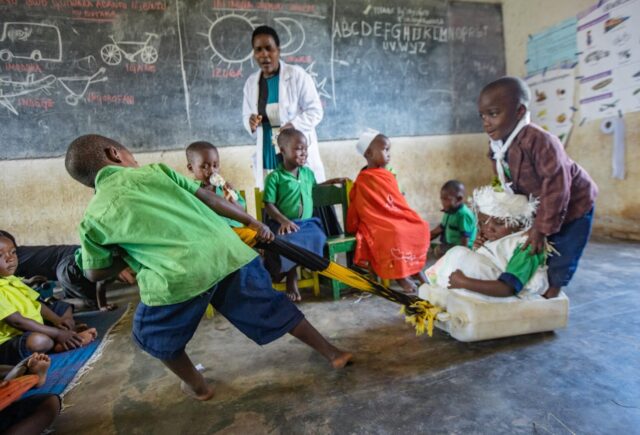A collection of essays edited by Evans Osabuohien, Gbadebo Odularu, Daniel Ufua and Romanus Osabohien, highlighting the weakness of many of Africa’s institutions, the role of China, and the prospects for an African Union Green Deal

In brief
- This is a dense, academic collection of essays, but three key messages emerge
- The pandemic has demonstrated the weakness of many of Africa’s institutions and services
- China’s role is worrying in five countries, although the essay here argues the risks of disruption are small
- The most important essay is one that examines the prospects for an African Union Green Deal which should adopt a similar approach to the European Union with some caveats
Although in terms of mortality, COVID-19 was less severe in Africa than in the developed world, its disruptive effects on economies and health systems were even more pronounced. This is chronicled in some detail in this somewhat dense collection of academic essays.
As the editors say “the outbreak of coronavirus (COVID-19) has resulted in diverse challenges ranging from health-related complications to food security, business development and humanitarian crisis management. These challenges highlight the urgent need for African countries to muster the necessary apparatus to develop resilience”.
For example one essay explores the availability of social services and their reliance levels, and uncovers the general weaknesses of the social services structure. Another examines the legal system in selected African countries (Angola, Ghana, Kenya, Nigeria, and South Africa) and develops a model for reform to support recovery.
Much of this will be familiar to impact investors operating in the continent, but two essays are of particular note.
The role of China
Marvellous Ngundu looks at how China has replaced the US as sub-Saharan Africa’s largest creditor over the last decade, accounting for approximately 40% of the region’s total debt stock. CARI’s dataset on Chinese loans to Africa for the period (2000 – 2018) shows they have rapidly increased from less than $1bn made in 2000 to $29bn made in 2016.
One chart shows China’s involvement has been enormous in five countries: Angola, Kenya, Ethiopia, Sudan and Zambia. In the case of Angola, Chinese loans for mining projects alone amount to nearly $18bn, which I calculate to be a quarter of the country’s entire GDP.
Ngundu notes: “The surge of Chinese loans in Africa has stirred debate among scholars and policymakers, with critics noting that China is leveraging its geopolitical agenda by trapping African countries into unsustainable loans. There are also growing concerns that African countries are prone to defaulting [on] Chinese debt repayments.”
However, somewhat lost amongst the author’s complex economic formulas is this statement: “It can, thus, be argued that the probability of African countries experiencing a debt crisis emanating from Chinese loans is around 2–5 %.” Something that is very significant if true.
We shall see.
A Green Deal for Africa
But perhaps the most important essay in this collection is one by Asekomeh, Azubuike and Gershon. This argues that an African Union Green Deal (AUGD) post–COVID-19 is “crucial to achieving sustainable economic growth and development within the continent’s Agenda 2063”.
Africa cannot rely on increasing GDP to finance a transition to renewable energy “due to the prevailing economic situation and the effect of increased energy demand”. This constraint is further amplified by the low motivation and capacity to pay tax, and the weak capital markets in Africa. “Therefore, to finance an AUGD, one vital consideration will be to reconcile African countries’ national strategic objectives with the interests of the few potential foreign direct investors.” This approach should include tax instruments and direct incentives like exemption from corporate taxes and import duties for green infrastructure.
“Another alternative to direct financing could be for African countries to remove barriers to green energy investment such as power market risks, permits/regulatory risk, transmission risk and counterparty risk, that discourage investors from investing in Africa’s renewable energy.”
According to the authors the EU has demonstrated a willingness to act as a single bloc, while Africa’s approach appears “individualistic”. For instance, nationally determined contributions (NDCs) are reported separately for each African country despite them having similar social-economic, geographical, and ecological attributes, and the existence of the African Union.
“The African continent should take advantage of collaboration opportunities within the continent and the European Union, thereby strengthening its financing and governance structures.” One of the main underpinnings for the EU’s Green Deal is a climate pact. The authors argue that “the agreement underlying the AfCFTA could be a legal basis for developing a climate deal for Africa”.
Above all, the authors say, is “the need for a thriving organised private sector to drive an African Green Deal”. But “the private sector in African countries consists of mostly small- and medium-scale enterprises (SMEs), some start-up firms and unregistered businesses operating in the informal sector. This is due to the scepticisms about the adequacy and consistency of government policies. This situation is in sharp contrast with the EU where many big private firms are connected to the realisation of the EUGD vision.”
Thus whilst advocating a European style model for Africa, the authors “caution that the EU’ s approach cannot be adopted in its entirety without considering the peculiar legal/regulatory, economic, financing, technological and governance issues of the African continent”.
Very interesting.





